To create great content consistently, it takes more than hiring great writers.
It takes more than writing long content.
It takes clarity.
Too often I talk to content marketers who, in some way or another, tell me the same thing:
“My company has spent over $10k last month on this content marketing thing and we’re getting no results! This isn’t working, I don’t think we should keep investing in content marketing at all.”
The problem doesn’t lie in the channel — content marketing — but the approach.
Carl Jung once said, “To ask the right question is already half the solution to a problem.“
I’ve never thought I’d quote an analytical psychologist in this blog, but he was dead on.
If you’re lagging behind this quarter’s results, follow the advice of good-ol’ Carl and ask yourself the right questions.
Why?
Because they’ll lead you to the problems you’re secretly blind of.
Let’s get started.
Are you hiring the right people?
Hiring people isn’t as important as hiring the right people.
If success was simply a matter of hiring the most people, everyone would be succeeding at content. Yet as the Content Marketing Institute report shows, only 24% of marketers say they’re very or extremely successful at managing their content marketing.
Content marketing is more than content, and it’s more than marketing. Ironic, yet crucial.
You can hire the best content writers, but take the marketing out of the equation, and no one will ever read your content.
Promote your content with Facebook ads, send tons of outreach emails, and leverage the audiences of top influencers, but if the content stinks, fuhgeddaboudit. You’ll get no results.
When hiring people for your content marketing team, you need:
- Someone who can write great content consistently
- Someone who can promote your content without being creepy
Hire content writers
Anyone can write, but doing it in a way that can engage people every time is hard. A great content writer can do that because he knows what it takes to create great content.
When hiring a writer, you want someone who can:
- Craft a story, even if it’s simple (as in the intro of this article)
- Be authoritative without lacking substance
- Be empathetic with the reader
- Have a great grasp of grammar and syntax
- Can explain any concept clearly
Most importantly, you want someone who can write great content consistently.
If you are thinking about hiring a content writer, look at their past 10 published articles. What topics has the writer published about? Are they all equally good?
Only hire writers that can keep up their content quality throughout time.
Hire marketers
Promoting content is tricky, as the point of content marketing isn’t to push for a sale right away, but to connect with the audience and leverage their trust to your advantage.
It takes specific marketing skills to do so, like:
- Focusing on long-term relationships with their targets (i.e., not sending 3 consecutive emails with link requests)
- Providing value before looking to get anything in return
- Having connections in the industry
- Knowing how to leverage a social community without being spammy
- Using copywriting techniques to promote the content
Such marketers are scarce. In order to find them, you need to ask for previous work.
Most importantly, you want to see how they build their relationships and promote their content.
What results has the marketer driven? How did she get them?
Hire content marketers
A content marketer needs to know how to promote that content as well. The problem is, promoting content isn’t like carrying out a paid media campaign. You can’t stuff your content into people’s throat.
I’ll be the first one to tell you it’s easy to find people who consider themselves content marketers, but few who can actually write and promote content equally well.
I’m personally better at writing than promoting (although I’m working on the latter). Some others are the opposite.
When you hire a content marketer, look for one that has a mix of both skills — writing and promoting — but has a predilection for one of the two skills.
It’s better to have a specialist who can then learn other skills than trying to find a unicorn right off the bat.
The few people who I’ve found to be real content marketers who can write and promote are people like Chris Von Wilpert and Aaron Orendorff, yet they’re extremely scarce.
Do you know what it takes to succeed?
When I was in high school, I wanted to be a historian.
One day, one of my teachers asked me what I wanted to study in college. Proudly, I said “history.”
I can still remember her rolling her eyes and saying “you clearly don’t know what you want.”
The sad part was that she was a historian.
“Know what you want before you do anything” is what I was told before I could even grow a full beard.
Coincidentally, that lesson applies to content marketing.
You need to know what you want before you can succeed with your content.
I know, I know, this is super obvious.
What I mean by “know what you want from your content” idea is this:
If you don’t know what the end result looks like — how you will use content marketing to grow your company’s revenue —, you won’t be able to hire the right people to help you.
More often that I’d like to say I see software companies publishing content which clearly no one besides the founders’ mothers would want to read.
It clearly seems they publish their content “because they have to.“
Before you even sit down to write down your content marketing strategy, you have to have a deep understanding of it as a marketing channel.
The lack of a clear idea of what content marketing can do for you will lead to an inefficient allocation of your resources that could lead to over investing in writers or underinvesting in planning, design, and promotion.
Here are three ways that will help you learn more about content marketing.
Look for stats and case studies
Start by learning what you can achieve with content. Study Content Marketing Institute’s B2B Content Marketing report I linked before and see how companies use content marketing.
Look at marketing reports and stats which show you what’s working and what other marketers do. Here are some ways you can find those stats:
- Companies like Marketing Sherpa, MarketingProfs, and Smart Insights often carry out studies of the industry.
- Econsultancy likes to publish the best stats they find every week.
- Look for marketing stats once a month or so and find the articles that curate the latest stats.
Case studies are goldmines full of incredible data. You’re not just looking at what other tell you what you should do; you are actually looking at what other companies have done and what results they’ve gotten.
An often overlooked way of finding great case studies is to go to software or agencies’ sites and look for the ones they post. While they can be slightly embellished, some of them are detailed and useful.
Of course, a much easier and scalable way of finding case studies is to Google “marketing case studies,” or similar variations, and check the results you get.
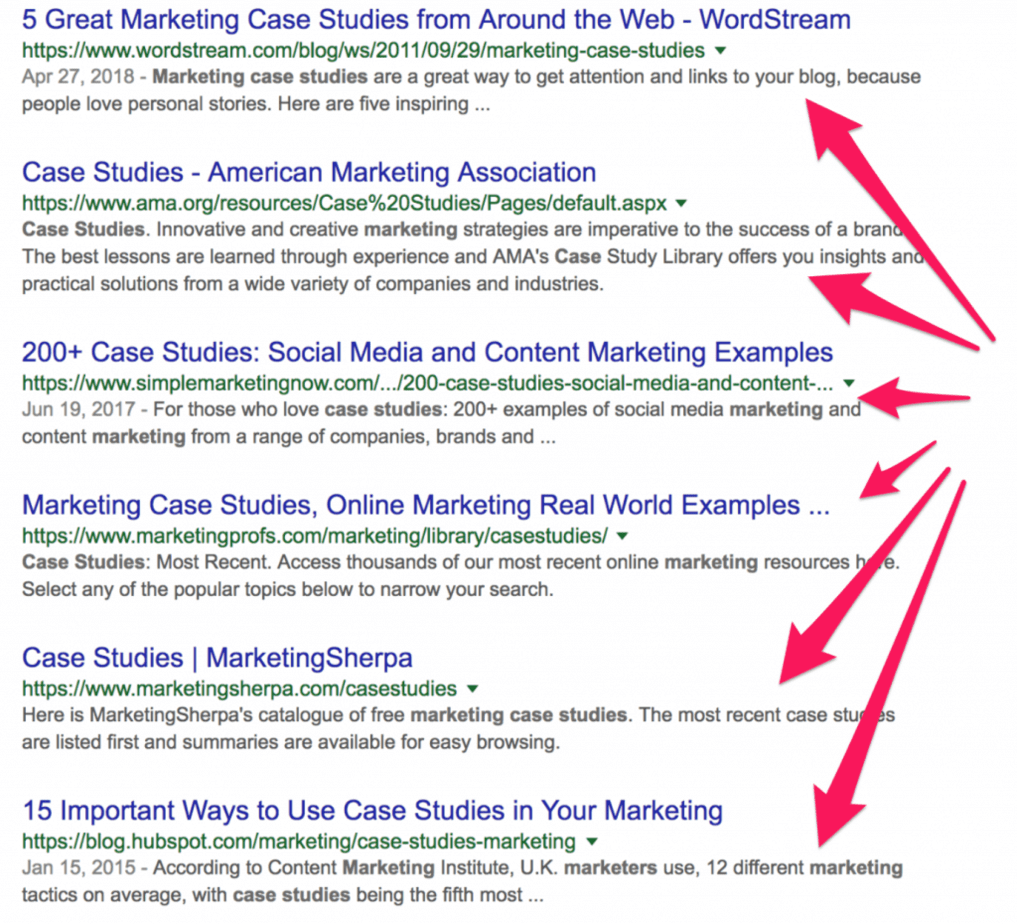
Even though you will have to do some digging, you will be able to find highly useful examples.
Talk to content marketers
I can’t stress this enough. To learn what you need, talk to someone who’s on the trenches. Forget what “experts” say and uncover what there is that content can do for you.
Go to your LinkedIn profile and check who’s a content marketer. Send them an email, schedule a coffee, or call them on Skype. (Send me an email, maybe? 
Whatever the option you choose, get out and start finding how content really works. Ask them questions like:
- How much time do you spend creating content versus promoting it?
- How do you define what topics to write?
- How do you promote your content?
- What results are you getting? What results have you gotten?
- What’s working great? What’s not?
- When did you start to see any results (if so)?
With a better idea of what you can get, define the goals you want to achieve. Discuss it with your marketing team, your executives, your investors, and whoever has a stakeholder position in your marketing activities. Get everyone involved in your success, because it will take a lot of work to get it.
Understand what it takes to succeed
A common mistake that can mislead many people into starting a corporate blog without getting any real success is the lack of a clear idea of what it takes to succeed in content marketing.
I’ve seen that many companies create half a dozen articles a month, many of which are high-quality, and yet they don’t grow.
Why does that happen?
The problem is that these companies fail to understand the steps that they need to succeed.
Great content is the start, the means to an end, but not the end in itself.
Companies need certain elements to succeed, including:
- Great writers
- A content strategy
- A content calendar
- A promotion strategy
Developing such strategies take a lot of work and a deep understanding of what you want to achieve through your content, but they will help you truly appreciate all the work you’ll have to do to succeed.
Note: If you haven’t developed a content strategy yet, check out this guide from Moz.
Succeeding with content takes long-term thinking, developing a good environment for growth, investing in the right people, and mixing both correct plannings with action.
Are you promoting your content?
“Content marketing.” The two words mean “the creation and promotion of content.”
Promotion is one of the two elements that make your content marketing strategy. If you don’t have a promotion plan to distribute your content, how can expect anyone to find it in the first place?
If you are an influential person like Neil Patel, you can publish your content without much promotion. The end goal of your promotion is to find an audience for your content; if you already have one, as Neil does, you will be already getting positive results from your content marketing efforts.
But if you see little to no traffic whenever you publish a new piece of content, the reason is simple: you aren’t promoting your content.
Remember, if you hire writers alone, you will create lots of content that no one knows. If you hire marketers alone, you will get mediocre content that everyone knows.
Either case is a bad situation.
Remember there are millions of articles published every day. If you don’t promote your content, no one will notice it.
“But Ivan, I’ve tried promoting my content and I still don’t get anywhere.”
If you are promoting the content and you still get no results, it may be that you’re going through some of the other three problems I mention in this article. That is:
- You don’t have the right people promoting the content
- You are hoping to get immediate results
- Your content plain sucks
If you somehow have avoided such problems and want some extra help, here are three tips you can use to improve your content promotion.
Having seen companies trying to promote their content
Content promotion tip #1: Don’t be a loudmouth
Promotion isn’t putting a link in a Facebook group and leaving it there, hoping people click on it and read it.
Promotion isn’t sending 50 emails to “influencers” who don’t know you to tell them to link to your stuff.
Promotion is understanding what’s going on in the space, participating in the conversation, and then adding your content to expand it.
Content promotion is understanding what’s going on in the space, participating in the conversation, and then adding your content to expand it.
If you are a loudmouth who speaks more or louder than others, no one will ever want to read your content. And what if you do get people to read it? Will they trust you? Probably not, because you didn’t win their trust yet.
Next time you go out to promote your content, look at online communities — Facebook groups, subreddits, other articles — and participate in them.
If you see people talking about a certain topic no one has ever covered, let them know. Tweet at them or send them an email. But only do that after you have validated such interest beforehand.
Analyze the space, and from what you get, you can promote where your content belongs.
Content promotion tip #2: Don’t hurry, think long-term
I know you need to hit the 10,000 monthly unique visitors by the end of next quarter, but if content, as explained below, it’s a long game.
When you go to promote your content, you must think long-term. Think about building relationships, giving value, and connecting with your audience.
If you want fast results, then you have it easy:
- Send an email to your list
- Promote it using paid media
In the first case, you are sending your content to a hungry earned group of people who want to read your content. In the second one, you are buying their interest.
There’s nothing wrong with either case, but by thinking long-term, you are building a brand.
There’s nothing as scalable as having a brand people are drawn upon. Remember that next time you are about to hit the “Publish” button in your WordPress blog.
There’s nothing as scalable as having a brand people are drawn upon.
Content promotion tip #3: Think of gaps and needs, not keywords or visits
At the end of the day, your content should help you build trust in your company so people can end up buying from you.
If you promote your content trying to hit a certain goal — like ranking for a keyword or number of visits — you’ll be getting traffic, but you may not get people to trust you.
Let me say this again:
Your content needs to build trust.
Such trust comes from publishing content that “reads” your customer’s mind. You get to do that by analyzing the gaps in content that exist and the needs people have unsolved.
If you think others have already done either, think again. There’s always something you can do no one else has. Find that gap, solve those needs, and you’ll get your visitor’s trust.
Unless you are a blogger or a media site owner who makes money by getting as many people to visit their site as possible, you want to think of the kind of relationship you build with your visitors every time you publish your content.
Yes, work to rank your pages as high as possible and get as many visitors as you wish, but think strategically.
The gaps and needs of your audience will be what grows your business, regardless of the number of visitors you get.
What expectations do you have?
Content marketing behaves like a child: it takes at least one year to make it walk on its own.
There’s no other way around it.
You need to commit for the long haul if you want to get any results.
Unfortunately, marketers often expect to increase their traffic and leads right away.
As I indicated before, content works when you connect your brand with an audience. That “connection” is built upon trust. Trust, on its own, takes time to build.
Let me give you an example:
How CoSchedule built trust with me
The other day I was talking to a client about the tools they use. He told me they use simple tools, like Google Docs for writing and editing, Trello for project management, and Google calendar to manage the timing of their posts.
Then I asked him if he ever heard of CoSchedule. He said he hadn’t. I told him they have a pretty cool content calendar tool that lets you organize your content production really well.
Here’s what makes this situation interesting: I don’t work for CoSchedule, I’m not affiliated with them, and I don’t personally know anything about them. I have written for them about content upgrades, and I like their product which I’ve used it once, but that’s all.
The reason why I recommended them is because I trust them. They publish great content consistently. They help me be a better content marketer, just like many other companies in the space. They have a great tool. Because my client needed some improvements in their content management, I thought about CoSchedule.
It all started with the trust they have earned.
Trust is about building a REAL connection
To make content work for you, you first create a connection with your visitor. This isn’t a “he-subscribed-to-my-email” connection. I’m not subscribed to CoSchedule’s email, yet they got my trust. I’m talking about a real, personal connection.
Such connection can take one touch point (i.e., a visit), dozens, or hundreds. It can take one minute or one year. Keep publishing often enough, speak to their problems, and you’ll build trust with your visitors.
Before you know it, you’ll get people talking about you, just like I did with this client and CoSchedule.
If you start with the wrong goal — like doubling your traffic in three months — and you will get disappointed.
The same can be said about larger goals, like trial sign-ups or sales.
You can create content to drive more sales, like webinars, ebooks, white papers, and case studies. But these content types belong to a wider marketing funnel. You can’t skip steps; you must start with the basics.
First, start by developing awareness of your brand through articles. Build the trust. Take the time to plant the seeds in your visitor’s mind.
Then, you can use gated content pieces to “convert” them into leads. You’ll increase the trust with more content, which you can send through emails, ebooks, or webinars.
Once the visitor (now a “lead”) trusts you, you can use the aforementioned content types to generate a sale. Or you can just tell them to sign up for your SaaS tool or request a consultation for your service.
It will take time. Never forget that.
What’s your content quality?
This is the most important content marketing question to ask, and I left it for the end due to one reason: it’s the most important one.
Look, your content can seem useful, valuable, and interesting. I’m sure you put a lot of effort as well as invest a lot of money into it.
But if after you publish it and promote it, you see few people commenting and sharing it, it may not be that good.
I know that because it happened to me.
I used to have an affiliate marketing blog (yes, I was one of those guys). Even though I used to publish long articles — way longer than my competition — I got nowhere. Not even after I got them to rank for certain competitive keywords.
People would read my content, and then they would leave. No clicks to my Amazon affiliate links, no sales, no commissions.
Why did that happen? Because my blog was awful, my content stunk, and I was an unprofessional young kind who didn’t know what he was doing.
I was doing everything right, yet my content wasn’t good enough to drive a sale.
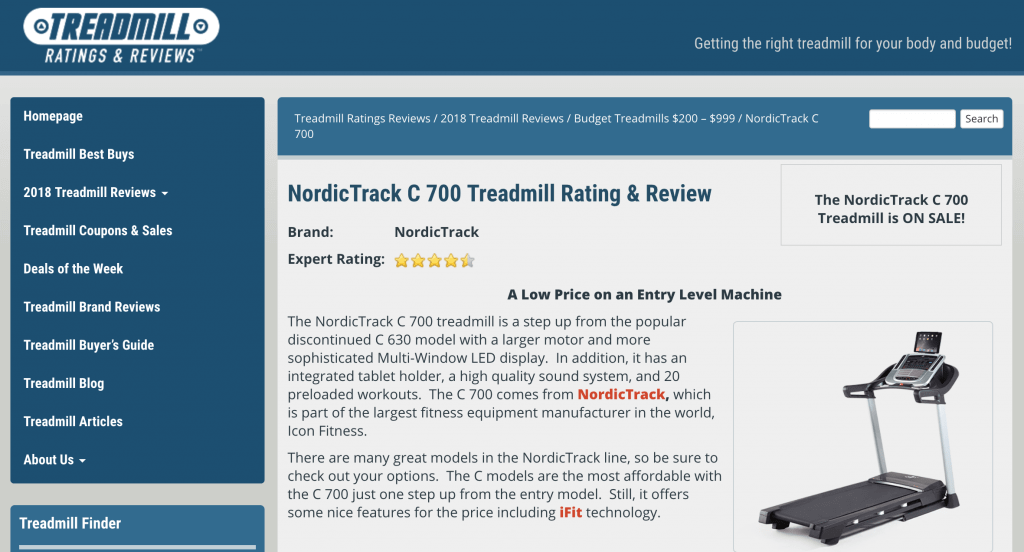
I was one of these guys, can you imagine?
It’s easy to overlook quality. After all, it’s a very subjective idea. How can you measure the quality of a piece of content? You can’t, that’s why it’s easy to say “write great content,” and leave it at that.
But you can’t get anywhere with bad content.
Unfortunately, I don’t have a formula nor a solution to this problem. I’m not going to provide you with a trademark-registered concept or a complex system to create great content either.
All I can do is point you to the possible reasons why your content sucks.
Important note: It’s easy to say your content is great because you feel like you’re not a bad marketer. And you probably aren’t. “The suckers are always them,” you say.
Look, I said the same things until I figure out that I was one of them. It can happen. Particularly when you fall for the other problems mentioned above.
Be brutally honest with yourself. Look at this list, then look at your content, and think deeply if you’re not falling for one of these mistakes. The first step of the AA program is to admit you have a problem with alcohol.
Similarly, the first step to improve your content is to admit your content sucks.
No new ideas
Refurbishing yet another “10 reasons why you should do SEO” isn’t going to make it, even if you have the best writing and most interesting story.
Your ideas need to be new. If not new, at least interesting. Find a new angle to an overpublished topic.
Be super honest, even if you use foul language.
Use images you create in Paint, even if they are ugly (it seems to work for Neville Medhora).
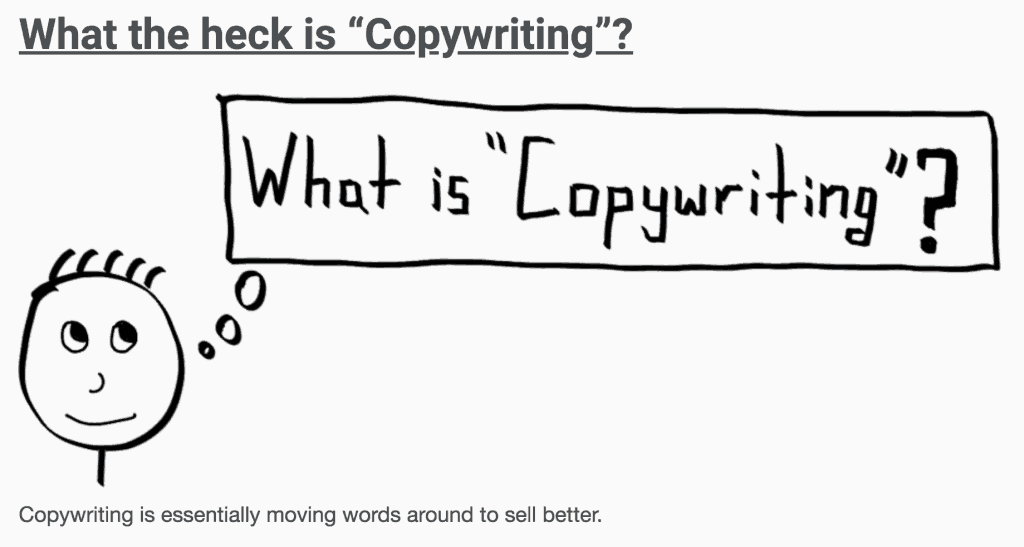
Make it shorter. Brake the rules and make your content shorter, super focused, like Derek Sivers.
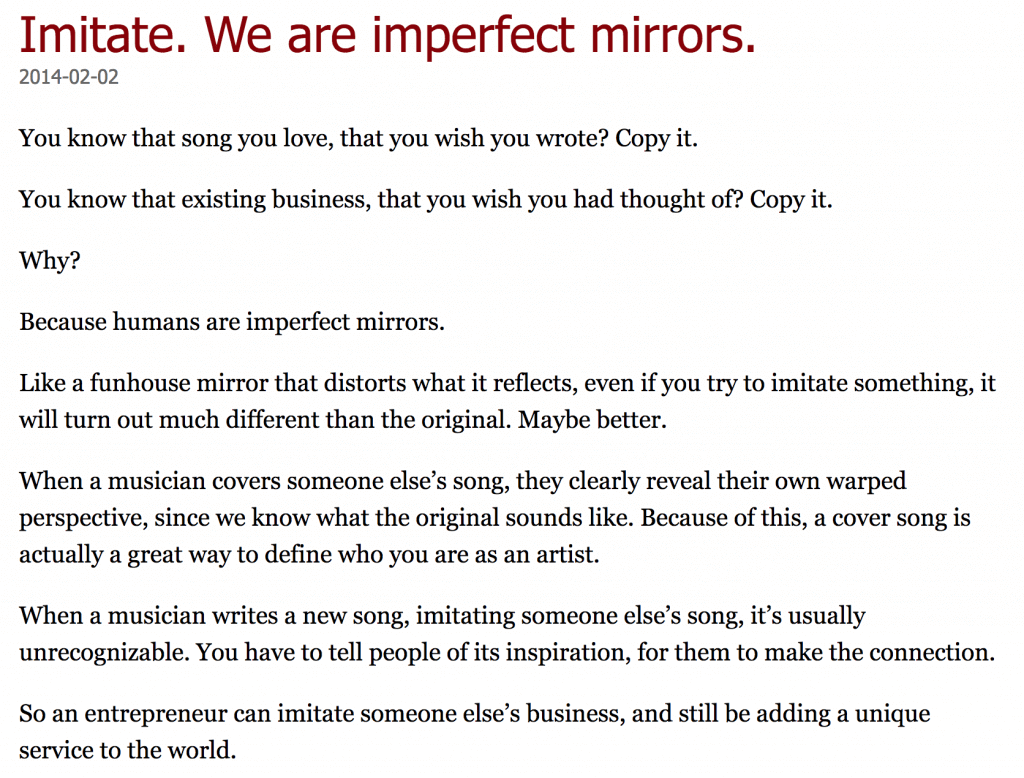
Be contrarian, but always have a point. If everyone says you need to provide great content all the time and you believe otherwise, and can make a great point, write about that.
Check your competition and see what they do. Break down what they do. If the all write superficial lists about one topic, write an in-depth guide about it. Or vice-versa.
Whatever you do, provide something new and original if you want to stand out.
Boringly written
I get that you want to communicate your brand’s values through your content. I understand you sell to large B2B companies.
But guess what? Just because you are selling to semi-bald 50-year olds with expensive suits doesn’t mean you have to write like in a college essay.
Check LinkedIn:
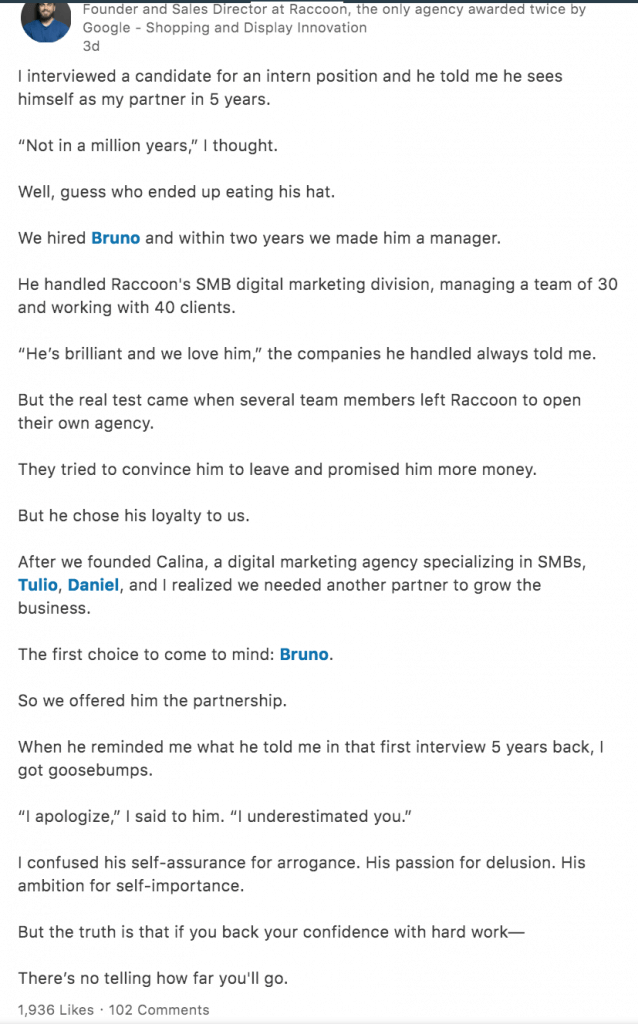
This kind of click-baity content is extremely popular because people like stories. It’s fun to read. It generates some thinking. It’s engaging.
People want to be entertained. Always.
Walt Disney said:
I would rather entertain and hope that people learned something than educate people and hope they were entertained.
Start with the idea of entertaining people. The slightest hint of entertainment will keep them focused on your content.
Does this mean you have to put a clown’s wig and speak funnily? Nope. It means you need to write in a compelling way that makes people want to read every single sentence of your content.
No stories
Following the previous idea, your content can’t be boring, and one way it is so is due to the lack of stories.
People love stories. Negative and hard stories make you vulnerable, yet that’s what people like.
Groove HQ was able to grow substantially after its founder, Alex Turnbull, wrote everything he learned as he grew his company. He invented the “from “aha” to “oh shit”” idea that many copied, including Neil Patel.
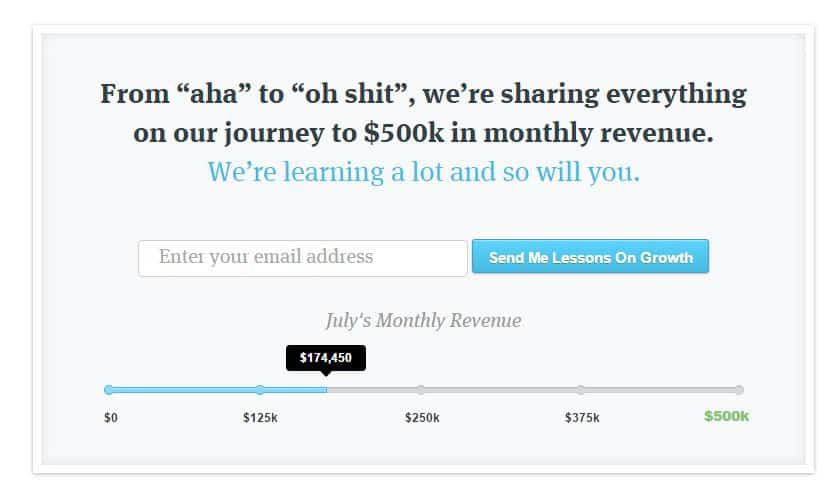
Leo Wildrich and Joel Gascoigne from Buffer followed a similar path. They launched a series of transparency-focused initiatives, first with their Open Salary calculator, which let you see what each member of the company makes and how much you could make working with them.
Then, they continue with a wide range of other initiatives, including Transparent Pricing, the Public Revenue Dashboard, and more.
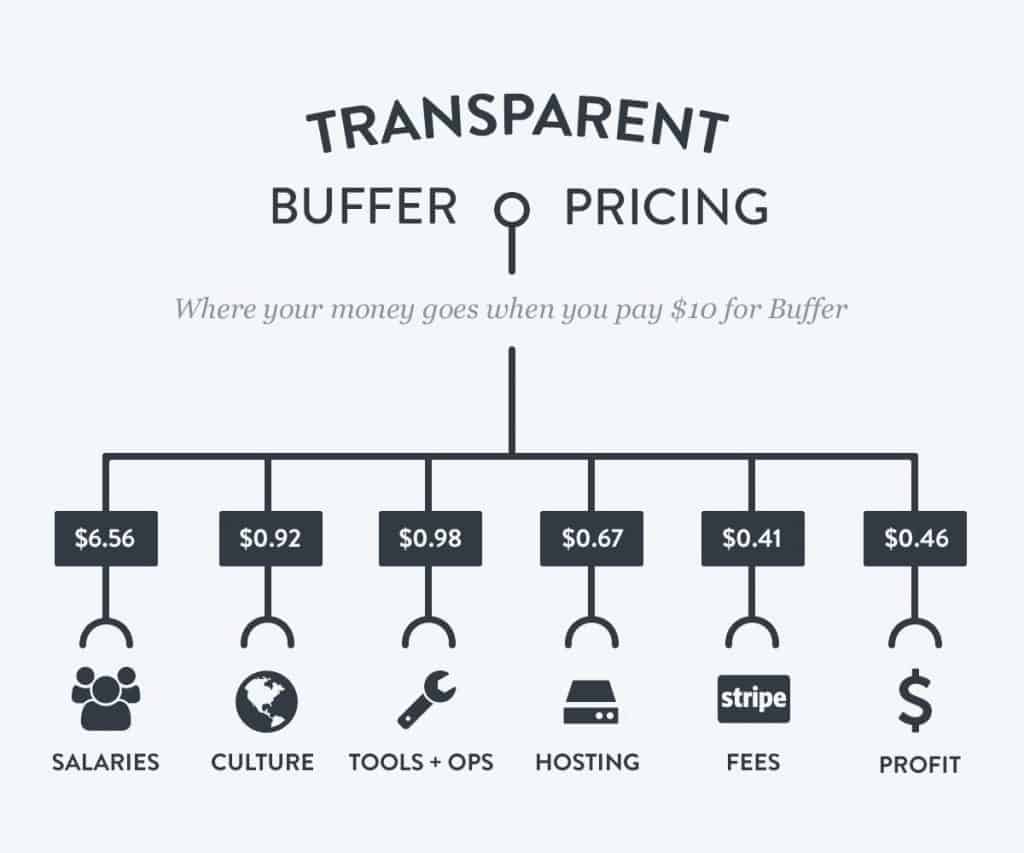
What this honesty and transparency say is one thing: companies are real. They tell a story of their values and how they act based on them.
You should too. You don’t need to invent a Pulitzer-level story. You don’t need to make it long either. What matters is that you show follow the elements of one.
Start with an intro. Continue with a conflict. Solve the conflict.

That’s pretty much it. From there, you can make it as complicated as you want. As long as you are telling a story, your content will be good.
Here’s what you need to do now:
Take a look at your analytics. What do you see?
Are you disappointed? Are you worried? Are you way behind your monthly or quarterly KPI’s?
If the numbers you are seeing aren’t the ones you wish you had, then dig deep into the problems you’re facing. Ask yourself the right questions.
Share your answers in the comments below and let’s talk to see how you can solve them.
There’s no money involved, promise. I just want to help you, free of any commitment.
It’s time you start getting the results you deserve.
